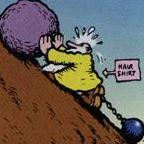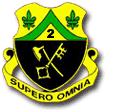CynicAl
Posts: 327
Joined: 7/27/2001
From: Brave New World
Status: offline

|
quote:
ORIGINAL: Adnan Meshuggi
Well...
i did not say "things would have been much better for the japanese"... just that the answer of your (rethorical) question isnīt so sure...
i mean, if the americans know everything about the plan, this could went wrong anyway.. because of xxxx (fill in something we havenīt thought about)...
It's always possible that some Mystery Factor XXXX that nobody's thought of can arise and change everything around. But if your plans depend on such an unknown - even to yourself! - factor, then I humbly submit that your plans need more work. 
quote:
also i (attention, my personal opinion) see the "old" american battlesips as not stable (BEFORE Refitting and repair),
In fact, I believe that all the Standards had received bulges (which would tend to increase stability) in prewar refits. I'm sure none of them were carrying the greatly increased - and correspondingly heavier, increasing topweight and decreasing stability - AAA suites they were fitted with later in the war. So I'm not sure exactly where you got that "unstable" idea from.
quote:
so, comaparing the huge but repairable damages at PH with deadly damages in the deep water, i belive the losses would be higher...
I really can't figure out why you assume the Japanese would inflict as much damage vs. maneuvering, screened, shooting targets as they did IRL against stationary, open, largely defenseless targets. At Pearl Harbor, they achieved ~50% hits with torpedos (~20 of 40 according to one fairly generous count), and quite a bit less with level bombing (<15 of 50, and they didn't have to worry about obstructed approaches). It is profoundly unlikely that they would do that well against maneuvering, defended targets - IRL the Kates hit with 7 torps in 70 drops (10%) over the course of 1942, and the level bombers would need a miracle to hit anything at all. Worse for Japan, the ships would have all watertight hatches secure, and damage control parties standing by to deal with the hits that do get through - so individual hits will be much less likely to be immediately fatal (i.e., no repeat of California going down to just two hits).
quote:
If the americans could surprise the japanese carrier fleet with guns, well here i canīt see this happen because of the speed advantage of the japanese... some salvos, maybe, but thatīs it.. 20-21 knots maximum speed compared with 30-31...
Who said anything about engaging Kido Butai with the battle line? I'm pretty sure it wasn't me. All I want is six hours' warning to get the fleet out of the harbor and safely over the horizon, in pretty much any direction. Given the RL IJN scouting plan from 7 December, not only will they never find my fleet, they won't even realize I'm not there and they have to search for it until a few minutes before the first wave of bombers arrives over the harbor! However, since you bring it up... 
Given really good intelligence, like supernaturally good, and at least one days' warning, it just might, maybe, be possible to get the fleet into position for an ambush. The Japanese do have a speed advantage of about 7 knots (Kaga was not a 30 knot ship!), but if they try to run they have a serious problem: Fuel. Even tanking up on both the outbound and return trips, the Japanese were operating at the ragged end of their rope off Oahu. If they have to make a long high-speed run (which burns off fuel much faster than cruising) in order to avoid a gunnery action with the US fleet, it's very likely that the DDs won't make it back to the tanker. For that matter, CVs Soryu and Hiryu could very well be in trouble too. So yes, they can run, but for how long? (Given sufficient warning - like a week or two - I'll try to put a submarine wolfpack in the general vicinity of the tankers, too.  ) )
There's another possibility, as well. If (admittedly that's one very big "if") the US fleet could spring the trap on Kido Butai while the air groups were busy over Oahu, Nagumo would be put in a very ugly position. His air groups would be looking for their CVs to be in a particular place when they return - if he runs, he misses the rendezvous. Of course he also misses the rendezvous if he doesn't run, but for a completely different reason...  So if(!) the timing's very good, they can run - but at the cost of their entire striking arm. So if(!) the timing's very good, they can run - but at the cost of their entire striking arm.
And of course, USN cruisers and destroyers most certainly could keep pace with Kido Butai, even if the Japanese did try to run. If the Japanese turn to fight the more numerous American light forces, they risk being caught up and overwhelmed by the battle line; if they don't, they risk being nickeled-and-dimed to death as they run.
quote:
nah, and if they do not hit critically the carriers (and american gunners were not battle hardened, the radar of 1941 wasnīt so good or built in (i could check it but i am too lazy in the moment) they will be sunk (again, just my opinion).
Sunk by what? After the morning raids, Kido Butai couldn't possibly have launched another strike until well after noon - too much flying time required traveling to and from PH, then more time to recover, repair, rearm, and refuel the aircraft. An ambush that hasn't sprung by then isn't going to happen anyway.
quote:
If the fighters could catch the japanese planes with surprise, this would be the "best" chance in my opinion, but i bet the american bombers would hit nothing in the try to bomb the japanese carrier fleet.
I more or less agree with this. There were ~150 fighters of various types based at various airfields around Oahu. Mostly P-40s, with a fair number of P-36s and some odds and sods in F4Fs and F2As detached from various Navy and Marine squadrons. The first Japanese strike was escorted by 45 A6Ms, the second by 33. The escorts would draw off a lot of the interceptors, but not all, and those that got through to the bombers would have themselves a really good day. Flak would take its toll, as well.
But most of the bombers on Oahu were Army level bombers. They're not likely to hit much, certainly not at this point in the war. However, there were a couple of squadrons of Marine dive bombers at Ewa - VMSB-231 with SB2Us, and VMSB-232 with SBDs. If they got through the Japanese CAP (say, because the fighters were all busy chasing off the Army planes) they could do some damage. Also, Halsey wasn't that far away with Enterprise and her air group; you'd better believe I'd invite him to the party too.
quote:
Also, if the battlewagons escape, this could lead to the wrong decision, to ignore the carriers and bet on the battleships...
but, sure, nobody could know it - only if this had happened... 
The USN wasn't really likely to "ignore the carriers" anyway. The naval rearmament programs started before the war planned to bring the number of fleet CVs in the USN up to about the same as the number of BBs. The fate of Force Z a couple of days later (nothing could have prevented that short of Phillips turning around and heading for Ceylon) would still serve as a glaring notice that armored ships could be overwhelmed and brought down by airpower.
We have a huge advantage, looking back, in that we know pretty much what both sides had, and didn't have, and what they did with it, and how well it worked. Realistically, just sortieing the fleet and sending them on a goodwill tour to Johnston I. or wherever would probably be the way to go.
_____________________________
Some days you're the windshield.
Some days you're the bug.
|
 Printable Version
Printable Version









 Yes, subthread - even though these boards really aren't organized that way. The "original" question I was responding to was the one I quoted, whether or not it's the same "original" question you had in mind.
Yes, subthread - even though these boards really aren't organized that way. The "original" question I was responding to was the one I quoted, whether or not it's the same "original" question you had in mind. 







 New Messages
New Messages No New Messages
No New Messages Hot Topic w/ New Messages
Hot Topic w/ New Messages Hot Topic w/o New Messages
Hot Topic w/o New Messages Locked w/ New Messages
Locked w/ New Messages Locked w/o New Messages
Locked w/o New Messages Post New Thread
Post New Thread